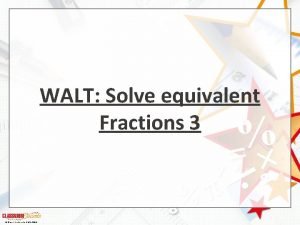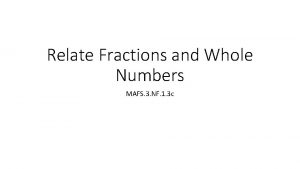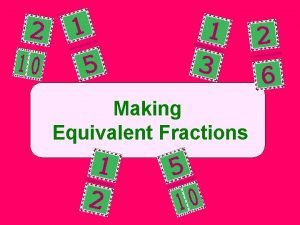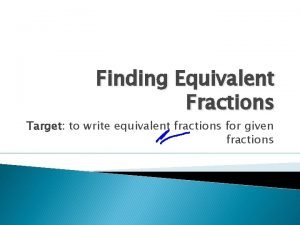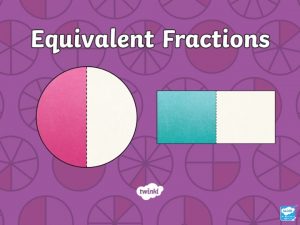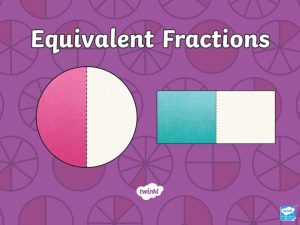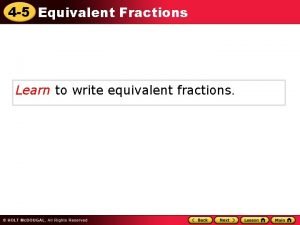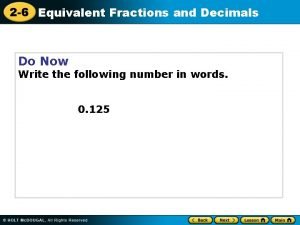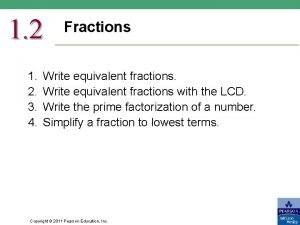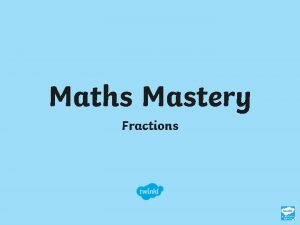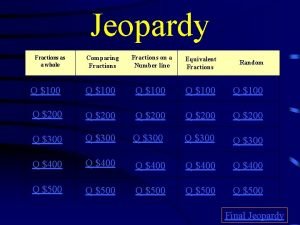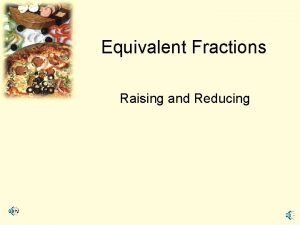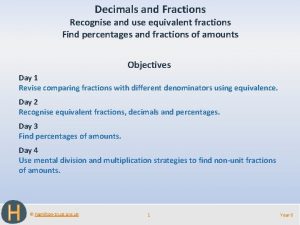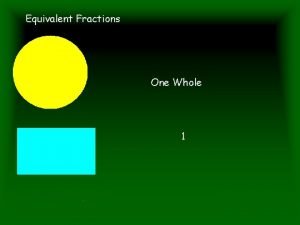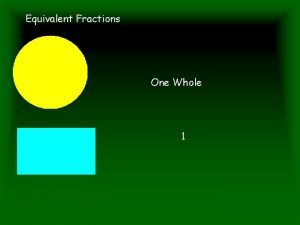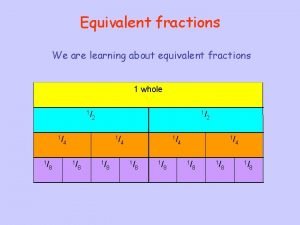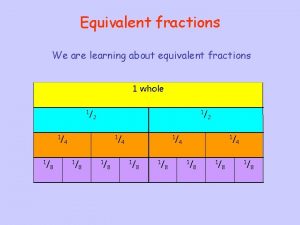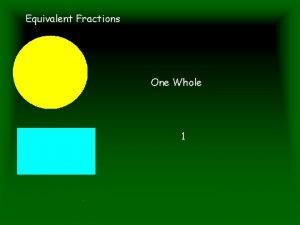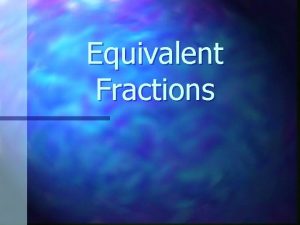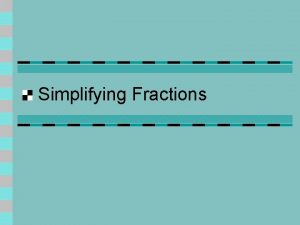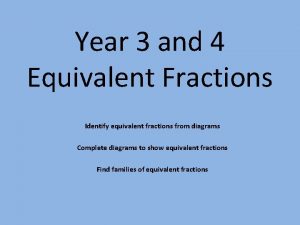4 5 Equivalent Fractions Learn to write equivalent
















- Slides: 16

4 -5 Equivalent Fractions Learn to write equivalent fractions.

4 -5 Equivalent Fractions Vocabulary equivalent fractions simplest form

4 -5 Equivalent Fractions that represent the same value are equivalent fractions. So are equivalent fractions. 1 2 = 2 4 = 4 8

4 -5 Equivalent Fractions Additional Example 1: Finding Equivalent Fractions Find two equivalent fractions for 10 ___ 12 = 15 ___ 18 = 10 ___. 12 5 __ 6 The same area is shaded when the rectangle is divided into 12 parts, 18 parts, and 6 parts. 10 ___ 15 ___ 5 __ So 12 , 18 , and 6 are all equivalent fractions.

4 -5 Equivalent Fractions Check It Out: Example 1 Find two equivalent fractions for 4 __ 6 = 8 ___ 12 = 4 __ 6 . 2 __ 3 The same area is shaded when the rectangle is divided into 6 parts, 12 parts, and 3 parts. 4 , ___ 8 , and __ 2 are all equivalent fractions. So __ 6 12 3

4 -5 Equivalent Fractions Additional Example 2 A: Multiplying and Dividing to Find Equivalent Fractions Find the missing number that makes the fractions equivalent. 3 __ 5 = ___ 20 3 • 4 ______ 12 = ____ 5 • 4 20 3 __ So 5 In the denominator, 5 is multiplied by 4 to get 20. Multiply the numerator, 3, by the same number, 4. 12 ___ is equivalent to 20. 3 __ 5 = 12 ___ 20

4 -5 Equivalent Fractions Additional Example 2 B: Multiplying and Dividing to Find Equivalent Fractions Find the missing number that makes the fractions equivalent. 4 __ 5 = 80 ___ 4 • 20 ____ 80 ______ = 5 • 20 100 4 __ So 5 In the numerator, 4 is multiplied by 20 to get 80. Multiply the denominator by the same number, 20. 80 ___ is equivalent to 100. 4 __ 5 = 80 ___ 100

4 -5 Equivalent Fractions Check It Out: Example 2 A Find the missing number that makes the fraction equivalent. 3 __ 9 = ___ 27 3 • 3 ______ 9 = ____ 9 • 3 27 3 __ So 9 In the denominator, 9 is multiplied by 3 to get 27. Multiply the numerator, 3, by the same number, 3. 9 ___ is equivalent to 27. 3 __ 9 = 9 ___ 27

4 -5 Equivalent Fractions Check It Out: Example 2 B Find the missing number that makes the fraction equivalent. 2 __ 4 = 40 ___ 2 • 20 ____ 40 ______ = 4 • 20 80 2 __ So 4 In the numerator, 2 is multiplied by 20 to get 40. Multiply the denominator by the same number, 20. 40 ___ is equivalent to 80. 2 __ 4 = 40 ___ 80

4 -5 Equivalent Fractions Every fraction has one equivalent fraction that is called the simplest form of the fraction. A fraction is in simplest form when the GCF of the numerator and the denominator is 1. Example 3 shows two methods for writing a fraction in simplest form.

4 -5 Equivalent Fractions Additional Example 3 A: Writing Fractions in Simplest Form Write each fraction in simplest form. 20 ___ 48 20 ___ The GCF of 20 and 48 is 4, so 48 is not in simplest form. Method 1: Use the GCF. 20 ÷ 4 _______ 48 ÷ 4 = 5 __ 12 Divide 20 and 48 by their GCF, 4.

4 -5 Equivalent Fractions Additional Example 3 A Continued Method 2: Use prime factorization. 20 ___ 48 = 2 • 5 _________ 5 = ___ 2 • 2 • 3 12 So 20 ___ 48 Write the prime factors of 20 and 48. Simplify. 5 ___ written in simplest form is 12. Helpful Hint Method 2 is useful when you know that the numerator and denominator have common factors, but you are not sure what the GCF is.

4 -5 Equivalent Fractions Additional Example 3 B: Writing Fractions in Simplest Form Write the fraction in simplest form. 7 ___ 10 7 is already The GCF of 7 and 10 is 1 so ___ 10 in simplest form.

4 -5 Equivalent Fractions Check It Out: Example 3 A Write each fraction in simplest form. 12 ___ 16 12 ___ The GCF of 12 and 16 is 4, so 16 is not in simplest form. Method 1: Use the GCF. 12 ÷ 4 _______ 16 ÷ 4 = 3 __ 4 Divide 12 and 16 by their GCF, 4.

4 -5 Equivalent Fractions Check It Out: Example 3 A Continued Method 2: Use prime factorization. 12 ___ 16 = 2 • 3 _______ 2 • 2 • 2 3 = ___ 4 Write the prime factors of 12 and 16. Simplify. 12 written in simplest form is ___ 3. So ___ 16 4

4 -5 Equivalent Fractions Check It Out: Example 3 B Write the fraction in simplest form. 3 ___ 10 3 The GCF of 3 and 10 is 1, so ___ is already in 10 simplest form.
 Facts about tactile learners
Facts about tactile learners 2/5 equivalent fractions
2/5 equivalent fractions Relate fractions and whole numbers
Relate fractions and whole numbers Missing equivalent fractions
Missing equivalent fractions What fractions are equivalent to 2/3
What fractions are equivalent to 2/3 Equivalent fractions chart
Equivalent fractions chart Equivalent fraction bingo
Equivalent fraction bingo Equivalent fractions multiplication chart
Equivalent fractions multiplication chart Equivalent fractions success criteria
Equivalent fractions success criteria Fraction 2/8
Fraction 2/8 4 5 equivalent fractions
4 5 equivalent fractions 2/6equivalent fractions
2/6equivalent fractions 48factor tree
48factor tree Equivalent fractions odd one out
Equivalent fractions odd one out Math jeopardy fractions
Math jeopardy fractions Pizza equivalent fractions
Pizza equivalent fractions Factors of 150
Factors of 150

